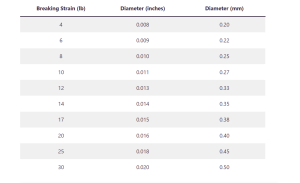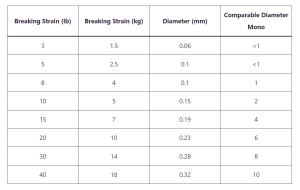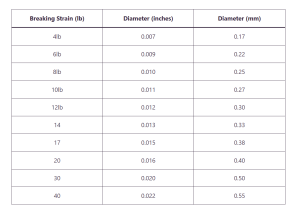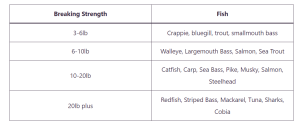When fishing in saltwater environments, we must choose a fishing line that meets the ability to withstand saltwater. How do we know what pound fishing line to use for saltwater? There will be many ways to determine, and this article will provide the most objective perspective.
Contents
Should I use braid or mono for saltwater?
With each different type of fishing line, there will be distinct advantages and disadvantages. Therefore, it will be difficult to answer which type should be used over the other in saltwater environments. However, I will list a few points to pay attention to below. First, knowing about the performance of both the monofilament fishing line and the braided fishing line in saltwater is essential.
The performance in a saltwater environment
The fact is that fishing in a saltwater environment is harsher than in a freshwater environment because of its corrosive nature. Therefore, both types of wires will have advantages when used in saltwater.
Monofilament fishing lines can resist UV rays, one of the factors that can damage your fishing line, better than other types of fishing lines, such as fluorocarbon or braided lines. In addition, the mono fishing line’s ability to not easily absorb water will also be a plus. This will help limit damage to the fishing line by salt water.
Braided fishing lines are also known for their ultra-thin sealing lines and ability to absorb water. This makes the braided fishing line not easily corrode quickly and is also resistant to UV rays.
The situation of using fishing line
Depending on what situation we use the fishing line in, it will be easier to determine whether to choose a mono fishing line or a braided fishing line.
A monofilament fishing line will be an excellent choice for anglers who like to fish in shallow water. Using a mono fishing line to fish in this area will bring a softer feel and be more complex for small fish to detect.
With braided fishing lines when choosing to fish in deep water, braided fishing lines help prevent the fishing line from stretching. In addition, braided fishing lines can be cast farther and do not sink easily, making it easier to make bait on the water.
The fishing techniques
Fishing technique is also one of the factors to consider. Standard fishing techniques include bottom fishing, jigging, and trolling.
The mono fishing line will best suit the bottom fishing technique. The mono-fishing line often has the ability to last longer than the braided line, making it impossible for fish to run away from the hook as strongly. This fishing technique is suitable for shallow fishing.
The braided fishing line will work better than the mono fishing line for jigging and trolling. Braided fishing lines are susceptible, making it easy for anglers to detect bites from large fish on the fishing line and helping them take timely action. At the same time, braided fishing lines float more quickly, so pulling fish to shore will be easier.
What pound fishing line to use for saltwater?
When you are about to buy any fishing line, the number listed on the box will be the maximum tolerance number of a fishing line. So, how can we determine how much pound is appropriate when fishing in saltwater environments? I will divide the case of fishing in saltwater inshore and saltwater offshore.
A mono fishing line with a 10-15lb test weight will be suitable for fishing in coastal saltwater areas. Mono fishing line is sturdy, durable, and highly abrasion resistant, which will be helpful when we fish in areas around rocks and corals. The knots created by the mono fishing line are also flexible and durable, which is considered one of the critical factors in determining whether a fishing trip is successful.
Meanwhile, a mono fishing line with a test weight of 20-23lb is recommended when offshore saltwater fishing. Because of its better abrasion resistance, mono fishing lines can be used better in harsh conditions. However, changing the mono fishing line to a braided one with an equivalent test weight is possible if we discuss more diverse techniques.
Table: Monofilament fishing line strength
The following compares the performances of the mono fishing line from Berkely Trilene. In general, the correlation between mono-fishing lines will stay the same.

Table: Braided fishing line strength
The following compares the performances of braided fishing lines from PowerPro. The relationship between braided fishing lines will change significantly as the weight increases.

Table: Fluorocarbon fishing line strength
The following compares the performances of the fluorocarbon fishing line from Berkley Vanish. This comparison shows the standard thicknesses of fishing lines.

What size fish can you catch on 15lb line?
15lb test fishing line is commonly used with mono fishing line, especially by beginner anglers. The mono fishing line will be suitable for flexible use in both freshwater and saltwater environments.
- Freshwater Fish: Carp, Freshwater Drum, Lake Trout and Largemouth Bass
- Saltwater Fish: Atlantic Bonito, Pacific Barracuda, Bluefish, Calico Bass, Chub Mackerel, Chem Salmon, Pacific Bonito, Pink Salmon, Sea Bass, Sockeye Salmon and Spiny Dogfish
Further reading: What is the best fishing line for trout?
In general, there is no fixed size that is appropriate, but with a 15lb fishing line, it will be flexible in different fishing environments.
However, braided fishing lines are recommended for use by professional anglers. The knots of this fishing line are more difficult to make than mono, and they will also cut your hand more quickly than mono. At the same time, the cost of owning a mono fishing line will also be higher.
Table: Fishing line strength chart by species

What is 20lb fishing line good for?
With a 20lb fishing line, this is considered a significant weight and very flexible. If you are a professional angler and want to challenge giant fish, this is one of the top choices. With a 20lb test fishing line, you can catch fish like marlin and tuna.
In addition, this type of line is also used in case you want to fish for smaller fish. They allow you to hunt small fish like panfish and salmon.
Regarding fishing techniques, they are suitable for processes requiring heavy equipment, such as jigs, spinnerbaits, Texas rigs, Carolina rigs, and small swimbaits. In addition, high wear resistance is also required.
The recommendation
However, with a test level of 6lb to 8lb, this is considered moderate for standard fishing requirements. When fishing in vital water, you should use a fishing line with a test strength of 12-15lb, which can help you increase your chances of winning the battle when fishing based on moderate durability and balance.
Conclusion
When fishing in saltwater environments, a fishing line with a 12-15lb test weight is recommended. However, choosing the appropriate type of fishing line will be necessary depending on your fishing technique and purpose.
If you find it useful, please support us by rating the article by rating the star and leaving comments for us to improve in other reports.


